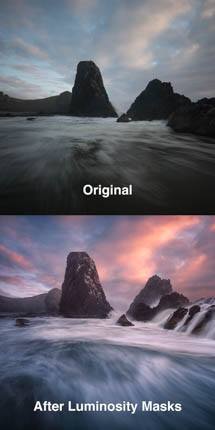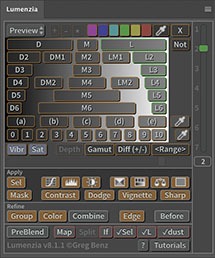This page contains a regularly updated reference to all software I know to support HDR display for photos (if you are not familiar, this is totally unrelated to the old “HDR” most of you know – see here for why this new display hardware is so incredible). If I’ve missed anything, please comment below.
Be sure to also see my list of recommended HDR monitors.
[Disclosure: This post may contain affiliate links. I rarely endorse other products and only do when I think you would thoroughly enjoy them. By purchasing through these links, you are helping to support the creation of my tutorials at no cost to you.]
Editing / exporting HDR photos:
- Web Sharp Pro (v6+) plugin for Photoshop – create HDR exports for Instagram & Threads, enhance any image from SDR to HDR, etc.
- Lightroom – Includes outstanding support for HDR with a very simple interface, as well as multiple options for exporting HDR images. Supported on every platform (Classic, Cloud, Mobile, Mac and PC).
- Adobe Camera RAW (ACR) – Includes capabilities similar to Lightroom (supported on Mac and PC).
- Photoshop – 32-bit mode includes display support (you must enable a tech preview).
- Lumenzia (Photoshop plugin) – supports luminosity masking in 32-bit mode.
- Affinity – Includes great 32-bit HDR editing and display support, but unfortunately lacks the ability to export gain maps (please add a polite comment requesting gain map (support).
- Pixelmator – This MacOS / iOS / iPadOS app supports HDR editing, exporting as HDR AVIF or JPG gain map.
- Zoner Photo Studio X – includes support for RAW processing as HDR
- GIMP provides support for 32-bit files, but I have not tested to see if it displays over-range values as HDR or simply shows a clipped display the way legacy versions of Photoshop do (i.e. you can edit HDR images, but I’m not sure if you will see the content as HDR or clipped).
The following do not support HDR: Adobe Bridge, CaptureOne.
BetterDisplay is also useful for photographers. It is not an editor – what it offers is many tools to help control MacOS display. One very nice feature is the ability to set a profile separately for SDR vs HDR mode, which would allow you to use a custom ICC profile in SDR mode (which is supported) and revert to the factory profile in HDR mode (there is no ICC standard for HDR and using a custom profile will cause HDR to clip to SDR).
Sharing HDR photos on your device:
These apps support HDR:
- Apple Photos, Preview, and QuickLook (iOS / iPadOS v18+, MacOS v15+) support ISO JPG, Apple gain maps (JPG or HEIF), AVIF, and JXL.
- Note: no HDR photo support in TvOS in v18
- Note: iMessage officially has support and does show on the sending device (when you click to view large, not the preview), but an apparent bug shows only SDR on the receiving device.
- Google Photos app (v7.24.0.747539053+) support Ultra HDR JPG
Sharing HDR photos online:
Social media / website support includes:
- Instagram – This includes iOS, Android, and desktop browsers for HDR photos in posts (not Stories). See here for details to share properly. Also supports HDR video in Reels.
- Threads – Similar to Instagram, but with higher resolution images.
- LR Web Galleries – This is a great way to publish your images directly from Lightroom to the web.
- HDR video support is available on FaceBook. HDR photos aren’t really supported, but if you share a link to your IG / Threads posts, a viewer using a browser (but not the FB app) will see the HDR version, so there’s a little support.
- You may share AVIF or HDR gain maps via self-hosted WordPress if you select the “full” size option in the media library (which avoids transcoding, which does not yet support HDR photos). You can even use website builders like Elementor, such as I used to create this JPG gain map demo page.
- WordPress v6.8 attempted to add support for HDR AVIF (not AVIF gain maps), but it is buggy and needs further work.
- Discord supports HDR in their app as well as in the browser when you upload an HDR PNG (it must be encoded with a CICP tag, which is what you’ll get when exporting from LR / ACR).
- zonerama.com supports HDR display.
- I haven’t used it personally, but they do a nice job of rendering HDR (AVIF) where supported and automatically falling back to SDR (JPG) when it is not supported.
- Their paid tier also includes an option to embed your gallery on another website, which should make it easy to integrate if you have an existing site. If you try it, please let me know your thoughts in a comment below.
Request support:
The following DO NOT yet support HDR photos (click links to help request support, your voice matters):
- Facebook (supports HDR video in Reels)
- Adobe Portfolio (myporfolio.com sites)
- Behance
- BlueSky
- Flickr
- SquareSpace
- Wix
- WordPress.com (you can use the “full” size to work with JPG gain maps, but derived images are not yet transcoded properly)
- 500px
- SmugMug
- Wix
- X (Twitter)
- Zenfolio
When submitting a request, you might reference https://gregbenzphotography.com/hdr#developers as a resource for developers.
Operating system support:
MacOS 15+, iOS 18+, and iPadOS 18+ support:
- Safari (and all other browsers) now support HDR thanks for WebKit updates in the v26 versions of MacOS, iOS, and iPadOS
- Photos app, iMessage, Preview, Finder (QuickLook fully, but thumbnails only for TIF and EXR)
- You can use your iPad as an HDR monitor for MacOS
- The Camera app captures HDR natively with gain map support for both JPG and HEIC (and RAW would naturally support HDR editing)
- Supported file types include: JPG with gain map (ISO or Apple encoding), AVIF, TIF, EXR.
Not yet supported: TvOS Photos app (though it supports HDR video), and AirPlay (though it supports HDR video with DolbyVision).
Windows is well supported through 3rd-party apps (nearly everything on this page), but does yet not have much support in tools like the File Explorer.
Android 14+ added significant support for HDR photos:
- Photos app
- Camera app captures HDR natively with gain map support
- Web browsing works great with JPG gain maps (and AVIF on Pixel Pro, Samsung shows banding for AVIF)
Web Browsers:
- Chrome – Supports HDR AVIF, JPG with gain map (AVIF with gain map supported under dev flag chrome://flags/#avif-gainmap-hdr-images). Also supports HDR video.
- Brave – same as Chrome.
- Edge – same as Chrome.
- Opera – same as Chrome.
- Safari has support in Tech Preview 215 onward, so general support is coming.
Not yet supported: FireFox (though it supports HDR videos).
HDR video:
This page is dedicated to HDR photography, but here are a few resources which may be helpful for sharing photos in a video format:
- LRTimelapse – create an HDR video timelapse from your HDR photos in Lightroom.
- Davinci Resolve works well with HDR photos when properly encoded (Web Sharp Pro can facilitate this)
Transcoding (reprocessing) HDR photos:
If you are a developer or looking to add support for uploading HDR photos to your website, the following open-source libraries are available:
- libultrahdr is a Google-backed open-source C++ library and CLI tool which supports encoding and decoding JPG gain maps (AVIF / HEIC apparently planned per discussions in the repo). It also supports transcoding (resize, crop, mirror, compress), making it a critical library or dependency to support transcoding for images uploaded to websites.
- ImageMagick has added support for libultrahdr (need to enable a flag when compiling, see here for details)
- There is a request for libvips to add support for JPG gain maps.
- There is a request for the Node.JS library Sharp to add support (Sharp is built on libvips)

